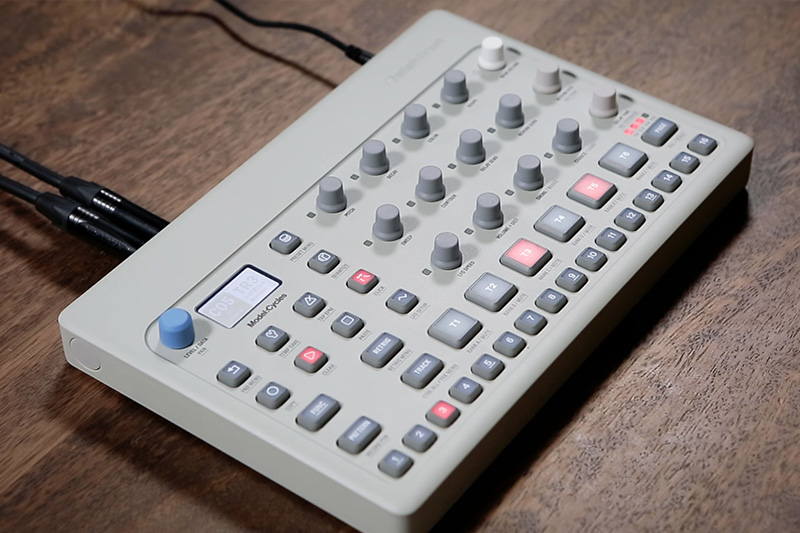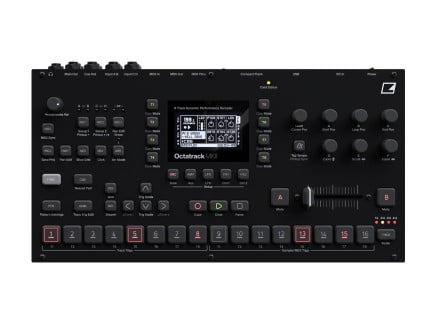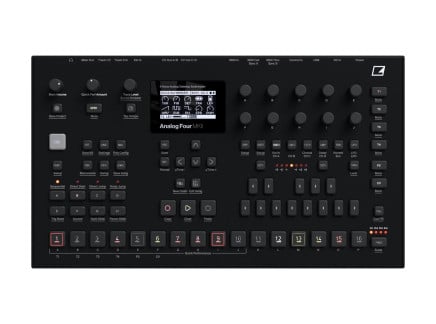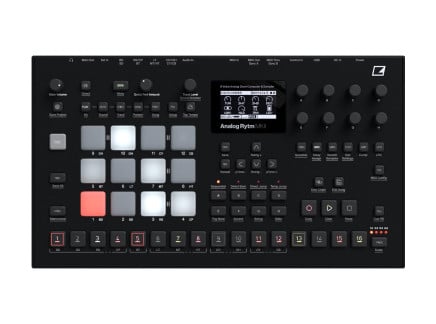In a recent virtual hang / live stream, we were able to catch up with our friend Mario Hernandez (aka StrangeStrains) from Elektron. Mario presented two live performances, both centered around the Digitone, Model:Cycles, Digitakt, SP404, and Analog Heat—creating everything from hard-hitting percussion to almost analog-like chords. We also chatted about some of Elektron's most recent developments—the Model:Cycles and the release of Overbridge 2.0.
The conversation flowed fairly seamlessly from topic to topic, but it revealed a lot of interesting ideas about some general topics—ranging from opinions about the nature of FM, the pros and cons of in-the-box v. out-of-the-box music making, and of course thoughts about the strengths of Model:Cycles, the newest addition to the Elektron family.
Elektron Model:Cycles and FM
Of course, one of the biggest topics of conversation was the Model:Cycles—Elektron's newest groove box. Developing on ideas from the Digitone, the Model:Cycles provides an even more accessible approach to FM synthesis...and at an even more affordable price point. When the Digitone was first released, it immediately gained wide acclaim because of its immediate, easily understandable way of navigating frequency modulation synthesis, one of the most notoriously complex synthesis methods. (We recently had a discussion about the Digitone and the ins and outs of FM, including some ideas about why it has such a reputation for complexity...you can check that out here.)

In our talk with Mario, we talked through some of the reasons the Digitone was so successful—namely, that it provided access to elements of more traditional synthesis (multiple waveforms, filters, etc.), giving people an entry point to start experimenting. And beyond that, the intuitive user interface makes it simple to immediately access different parameters of the sound and hear how changing them relates to the resultant sound...forming the type of visceral cognitive link that emerges with an analog instrument.
The Model:Cycles takes this approach to the next level by almost entirely dispensing of traditional FM concepts like algorithms, ratios, and indices, and instead focusing on an approach that uses FM to create types of sounds commonly used in electronic music. Model:Cycles organizes its synthesis capabilities into "machines," each of which provide four machine-specific variable parameters. The Machines include Kick, Snare, Metal, Perc, Chord, and Tone—great for everything from huge FM basses to metallic percussive hits, pounding kicks, and easy chord generation. Rather than knowing which FM algorithm you need to turn to to make a good snare sound, for instance, you can simply pull up the Snare machine on any track...making it dead simple to get straight to the types of sounds you want to make, complete with many of the desirable quirks and colorful sound of traditional FM approaches.
Additionally, each of the box's six tracks can be set to use any machine—so you could have six kick tracks all at once, or two "tone" tracks and four chord tracks, or any other combination of voicings. And because the four variable parameters per machine have such an astonishing range, even a single Machine is typically capable of far more than its name might suggest. Check out our release party for the Model:Cycles, featuring extended performances from Mario and Mod:Cycs designer Ess Mattison:
One person might use the Model:Cycles as an FM drum machine...someone else might use it as a spacey, ambient drone box...and someone else might use it as an all-in-one production station. In the end, it is remarkably flexible, and honestly? It's kind of a no-brainer for the price.
Overbridge 2.0
And of course, the other recent big announcement from Elektron: Overbridge 2.0. For those not familiar, Overbridge is Elektron's proprietary method of integrating their hardware devices with software production environments. Recent updates to this environment answer a lot of questions Overbridge users have had for ages...and now, the platform is more stable and more powerful than ever before.
Overbridge provides a ton of useful functionality to supported Elektron hardware (which includes, at the present time, the Mk1 and Mk2 Analog series instruments and the Digi instruments). One of the most notable features is its expansion of the devices' user interfaces—when your Elektron device is plugged into your computer, you can load Overbridge as VST in your preferred DAW and have a fully functional user interface for the device onscreen, capable of controlling the instrument in realtime via onscreen interaction or automation form the DAW itself. The other pretty mind-blowing feature? Overbridge allows you to stream all tracks from your device into the DAW on independent channels...so even though devices like the Digitone don't have per-track analog outputs, you can still record each track independently for mixing/editing further down the line. And of course, this in many cases can circumvent the need for an audio interface altogether...so if you're a computer-based musician looking to transition into the world of hardware, this seamless integration will get you up and running quickly, and permits workflows that should already be quite familiar to you.
Overbridge has a ton of other features—it acts as a preset manager, runs standalone, and can even record individual tracks in standalone mode without needing to open a DAW.
The rest of Mario's conversation drifts around a ton of colorful and compelling topics, ranging from the evolution of electronic instrument design to the pros and cons of working in the box, and all the way to tactics for building up a performance setup and getting started with electronic music. It's impossible to cover everything in a quick article, so definitely make sure to listen through the stream—you just might learn something about Elektron gear, or about music making altogether.










